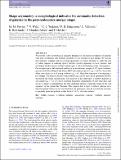Files in this item
Shape asymmetry : a morphological indicator for automatic detection of galaxies in the post-coalescence merger stages
Item metadata
| dc.contributor.author | Pawlik, Milena | |
| dc.contributor.author | Wild, Vivienne | |
| dc.contributor.author | Walcher, C. J. | |
| dc.contributor.author | Johansson, P. H. | |
| dc.contributor.author | Villforth, Carolin | |
| dc.contributor.author | Rowlands, Kate Elizabeth | |
| dc.contributor.author | Mendez Abreu, Jairo | |
| dc.contributor.author | Hewlett, Tim | |
| dc.date.accessioned | 2016-01-25T14:40:04Z | |
| dc.date.available | 2016-01-25T14:40:04Z | |
| dc.date.issued | 2016-03-01 | |
| dc.identifier | 239951693 | |
| dc.identifier | af37d3e9-5ea7-4c0a-b85c-f6630856ea86 | |
| dc.identifier | 84971597002 | |
| dc.identifier | 000372265200058 | |
| dc.identifier.citation | Pawlik , M , Wild , V , Walcher , C J , Johansson , P H , Villforth , C , Rowlands , K E , Mendez Abreu , J & Hewlett , T 2016 , ' Shape asymmetry : a morphological indicator for automatic detection of galaxies in the post-coalescence merger stages ' , Monthly Notices of the Royal Astronomical Society , vol. 456 , no. 3 , pp. 3032-3052 . https://doi.org/10.1093/mnras/stv2878 | en |
| dc.identifier.issn | 0035-8711 | |
| dc.identifier.other | BibCode: 2015arXiv151202000P | |
| dc.identifier.other | BibCode: 2016MNRAS.456.3032P | |
| dc.identifier.uri | https://hdl.handle.net/10023/8073 | |
| dc.description | MMP and VW acknowledge support from the European Career Reintegration Grant Phiz-Ev (P.I. VW). VW, KR and JM-A acknowledge support from the European Research Council Starting Grant SEDMorph (P.I. VW). CJW acknowledges support through the Marie Curie Career Integration Grant 303912. PHJ acknowledges the support of the Academy of Finland grant 1274931. | en |
| dc.description.abstract | We present a new morphological indicator designed for automated recognition of galaxies with faint asymmetric tidal features suggestive of an ongoing or past merger. We use the new indicator, together with pre-existing diagnostics of galaxy structure to study the role of galaxy mergers in inducing (post-) starburst spectral signatures in local galaxies, and investigate whether (post-) starburst galaxies play a role in the build-up of the ‘red sequence’. Our morphological and structural analysis of an evolutionary sample of 335 (post-) starburst galaxies in the Sloan Digital Sky Survey DR7 with starburst ages 0 < tSB < 0.6 Gyr, shows that 45 per cent of galaxies with young starbursts (tSB < 0.1 Gyr) show signatures of an ongoing or past merger. This fraction declines with starburst age, and we find a good agreement between automated and visual classifications. The majority of the oldest (post-) starburst galaxies in our sample (tSB ∼ 0.6 Gyr) have structural properties characteristic of early-type discs and are not as highly concentrated as the fully quenched galaxies commonly found on the ‘red sequence’ in the present day Universe. This suggests that, if (post-) starburst galaxies are a transition phase between active star-formation and quiescence, they do not attain the structure of presently quenched galaxies within the first 0.6 Gyr after the starburst. | |
| dc.format.extent | 21 | |
| dc.format.extent | 5695278 | |
| dc.language.iso | eng | |
| dc.relation.ispartof | Monthly Notices of the Royal Astronomical Society | en |
| dc.subject | Galaxies: evolution | en |
| dc.subject | Galaxies: interactions | en |
| dc.subject | Galaxies: starburst | en |
| dc.subject | Galaxies: structure | en |
| dc.subject | QB Astronomy | en |
| dc.subject | QC Physics | en |
| dc.subject | 3rd-DAS | en |
| dc.subject | BDC | en |
| dc.subject | R2C | en |
| dc.subject.lcc | QB | en |
| dc.subject.lcc | QC | en |
| dc.title | Shape asymmetry : a morphological indicator for automatic detection of galaxies in the post-coalescence merger stages | en |
| dc.type | Journal article | en |
| dc.contributor.sponsor | European Research Council | en |
| dc.contributor.institution | University of St Andrews. School of Physics and Astronomy | en |
| dc.identifier.doi | https://doi.org/10.1093/mnras/stv2878 | |
| dc.description.status | Peer reviewed | en |
| dc.identifier.url | http://arxiv.org/abs/1512.02000 | en |
| dc.identifier.url | http://adsabs.harvard.edu/abs/2015arXiv151202000P | en |
| dc.identifier.grantnumber | ERC-2012-StG-20111012 | en |
This item appears in the following Collection(s)
Items in the St Andrews Research Repository are protected by copyright, with all rights reserved, unless otherwise indicated.

